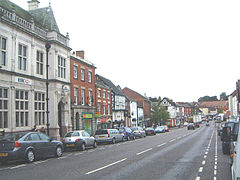Powerflush nearby to Ashby-de-la-Zouch
What is powerflushing?
Powerflushing is a process that involves pumping water at a high velocity through your heating system in order to remove any sludge, debris or corrosion that has built up over time. This build-up can cause your heating system to become less efficient and can even lead to breakdowns. Powerflushing will clean your system and help to restore it to its original efficiency.
 Ashby-de-la-Zouch, also known as Ashby de la Zouch, is a market town and civil parish in the district of North West Leicestershire and the ceremonial county of Leicestershire, England. The town is close to the borders of Derbyshire and Staffordshire. Its population of 11,410 in 2001 increased to 12,370 in 2011. In the 15th–17th centuries, Ashby de la Zouch Castle was significant. The town’s main industries in the nineteenth century were ribbon manufacturing, coal mining, and brickmaking.
Ashby-de-la-Zouch, also known as Ashby de la Zouch, is a market town and civil parish in the district of North West Leicestershire and the ceremonial county of Leicestershire, England. The town is close to the borders of Derbyshire and Staffordshire. Its population of 11,410 in 2001 increased to 12,370 in 2011. In the 15th–17th centuries, Ashby de la Zouch Castle was significant. The town’s main industries in the nineteenth century were ribbon manufacturing, coal mining, and brickmaking.
The hamlets of Shellbrook to the west and Boundary to the north-west are part of the civil parish. Swadlincote, Burton upon Trent, Melbourne, and Coalville are all within 10 miles (16 kilometres), and Derby is 112 miles (19 kilometres) to the north. On the A42 between Tamworth and Nottingham, Ashby is located in the heart of The National Forest, about 24 miles (39 km) south of the Peak District National Park. Ashby Market Street was named “Best Shopping Experience” in 2018, and it reached the finals of the rising-star category for UK high streets in 2019.
Click this page for powerflushing service in heating systems in these postcode areas:
HISTORY
In 1086, the town was known as Ashby. This is an Anglo-Danish word that means “Ash-tree farm” or “Ash-tree settlement.” The Norman French name extension dates from the years following the Norman conquest of England, when Ashby was acquired by the La Zouche family during Henry III’s reign.
The castle at Ashby de la Zouch was built in the 12th century. The Hastings family took control of the town and castle in 1464, and William Hastings, 1st Baron Hastings fortified it beginning in 1473. During the English Civil War, the town was one of the Cavaliers’ main garrisons, commanding the North Midlands Army under Colonel Henry Hastings, 1st Baron Loughborough. When the town fell after a long siege in March 1646, the surrounding towns and villages rejoiced.
During the First World War, a German enemy Zeppelin flew over the town.
Many of the structures on Market Street, the town’s main thoroughfare, are made of wood. The majority of this structure is hidden behind later brick facades. The Bull’s Head public house still has its original Elizabethan half-timbering, though most of it has been plastered over and is no longer visible from the street. A short distance down Market Street is a shop that is currently occupied as a LOROS Charity Shop and still has its original Elizabethan timbers visible from the street. This street is also lined with Regency-style buildings. Rawdon Terrace, a row of Classical-style houses on Bath Street, dates from the 1820s, when the town was a spa destination.

